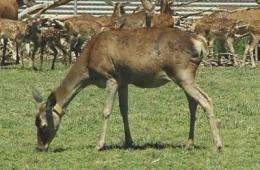Dominant deer hinds choose the best food

Deer hinds (Cervus elaphus) have a hierarchical organisation system: the oldest and largest hold the most dominant positions. Therefore, a nutrient rich diet benefits the more dominant hinds, who have preferential access to the best food sources. This allows them to grow even bigger, improving their milk production and body condition.
Published in the PLoS ONE journal and headed by the University of Castilla-La Mancha (UCLM), the study demonstrates how even when food is in abundance, the dominant hinds select the best foods.
Carried out in 2009 on the Albacete experimental deer farm, the second most important in the world (after the one in New Zealand), the experiment lasted seven days. It involved observing the behaviour of 44 deer hinds when accessing food during the first hour, their selection of food components and their nutritional composition.
The results reveal that the "dominant hinds used more time to feed during the first hour after the food was put out, they selected cereals and rejected food pellets (nutritiously low vegetable by-products)," as explained to SINC by Francisco Ceacero, lead author of the study and researcher at the department of Science and Agro-Forest and Genetics Technologies of the UCLM.
The hinds chose the food according to energy and fat content. According to Ceacero, "food quality gets lower and lower the further away we move from the time in which the food is put out. In this way, the dominant hinds receive more energy in their diet whereas their subordinates do still get to eat enough but only the poor quality food that is left behind."
The same goes for cows and sheep
Although the discussion continues on the mechanisms that drive these animals to know how to select the best food that meets their requirements every time, the scientist ensures that "the preferential selection of certain foods and the total rejection of others is clear in both diet selection studies on wild animal populations and experiments in captivity."
The experiment combined behavioural study techniques (hierarchy and food access observation), ecological study techniques (diet component selection) and nutrition study techniques (nutritional value of each food item and the dietary intake itself).
The team of authors, which also included Tomás Landete-Castillejos and Andrés José García from the Research Institute of Hunting Resources, suggests that the results are also applicable to other social ruminants like cows, sheep and goats.
More information: Ceacero F, García AJ, Landete-Castillejos T, Bartošová J, Bartoš L, Gallego L (2012) "Benefits for Dominant Red Deer Hinds under a Competitive Feeding System: Food Access Behavior, Diet and Nutrient Selection". PLoS ONE 7(3): e32780. doi:10.1371/journal.pone.0032780 , 2012.
Journal information: PLoS ONE
















